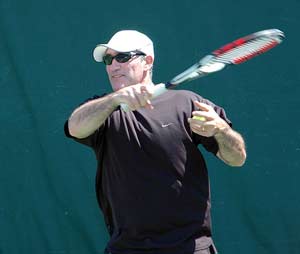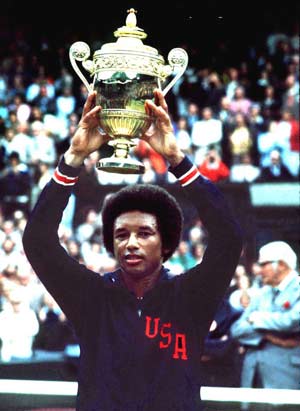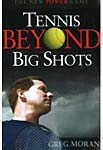| TennisOne Lessons Good Thinking Tops Great Strokes Greg Moran
You may not have the most beautiful strokes at the courts or take a lot of lessons but that doesn’t mean you can’t be a winning tennis player. Brad Gilbert proved this during his twelve year career on the pro tour. Though a frustrated opponent once compared his strokes to “a caveman who found a tennis racket,” Gilbert notched wins over such players as John McEnroe, Boris Becker, Pete Sampras, Jimmy Connors and Andre Agassi to name a few. Ranked in the top ten for five years, he reached a career high of number 4 in the world in 1990. Gilbert, whose style of play was frequently described as "winning ugly," says in his book of the same title that "pretty strokes are okay.But there's a lot more to the game than that." Tennis matches aren't won by the players with the nicest looking strokes but rather those who don’t beat themselves, understand the percentages, analyze their opponent's games and come up with a game plan for victory.
When Jimmy Connors walked onto the court for the 1975 Wimbledon final he was the undisputed king of the tennis world. Twenty-two years old, Connors was the defending Wimbledon and U.S. Open champion and hadn’t lost a set in the tournament. His opponent was 31 year-old Arthur Ashe. Ashe’s career was on the decline and London bookmakers had made him a 5-1 underdog. Many insiders felt he would do well to win a set. Connors won the first game of the match. Ashe won 12 of the next 13 and a short while later became the first black man to win Wimbledon. Ashe’s 6-1, 6-1, 5-7, 6-4 victory is still today considered one of the greatest upsets in tennis history. The night before the final, Ashe and a few of his friends got together over dinner and came up with a game plan to defeat Connors. They made a list of 5 or 6 things for Arthur to focus on during the match. Ashe took this list to the court, referred to it during changeovers and took out the “unbeatable” Connors in four sets. Whether your strategy is to simply keep the ball in play while waiting for an error or something more complex, learning to analyze your competition and putting together a game-plan are vital ingredients towards victory against players at the 4.0 level and above. It begins with the warm-up Beginning with the warm up and continuing throughout the match, you should be gathering information on your opponent’s strengths, weaknesses and tendencies. Feed a ball right at his body and see which stroke he chooses to hit. This might tell you whether he prefers his forehand or backhand---an important piece of information As you’re hitting back and forth, take note of things such as:
Give him a variety of shots: high, low, soft, hard and see how he reacts. Does he hustle after the ball or does he let it bounce twice. How well does he bend for low balls? How about moving back for an overhead? Does he seem relaxed or uptight? Does he get angry at himself over missed shots? Pay attention to all of these and begin to get a feel for his game and temperament. If you’re playing doubles, take note of these same things with each player on the opposing team but also try to see which member of the team appears to be the leader. The leader is often the stronger player and knowing that right off the bat will give your team a big advantage. When you spin the racket, see which member of the team calls “up or down” and makes the decision whether to serve or receive. That player may very well be the leader. A Final Word About the Warm-up
Don’t be too concerned if, during the warm-up, it seems as if you’re on the court with Andy Roddick. Many players, in an attempt to get the upper hand will start hitting big shots right off the bat. They hope that by “winning the warm-up” they’ll intimidate you when the “real” match begins. Don’t panic. You’re not playing Andy Roddick and I can assure you that these “win the warm-up” players won’t be quite as smooth and loose once the score is being kept. Start Off like a Backboard and Play the Percentages During the first two or three games, keep the ball in play and focus on playing classic “percentage” tennis. By hitting a lot of balls during the first few games, you can continue to check out your opponent as well as settle into a comfortable rhythm. As the match progresses and you learn more and more about your opponent’s skills, both technically and strategically, you can begin to make them work for you. Singles: Here are 10 things you might notice in your opponent and how to use them to your advantage:
When playing doubles, look for:
These are just a few examples of what to look for when you analyze your opponent’s games. Become an aware player and pay attention to everything. The more information you can gather, the better you’ll be able to devise your game plan. When facing players, or teams, at the 3.5 level and below, you’ll find, early on, that all you need to do is hit a few balls back in the court, use the percentage plays, and wait for your opponents to beat themselves. However, as your game improves, and you’re playing at the 4.0 level and above, tennis becomes much more of a strategic battle where the thinking player (or team) will almost always come out on top. Knowing how to analyze and take advantage of your opponent’s game is your first step towards winning matches at the higher levels. Your comments are welcome. Let us know what you think about Greg Moran's article by emailing us here at TennisOne.
Tennis Beyond Big Shots presents a bold back-to-the-future approach. A new game that moves away from power and big shots yet is more lethal to opponents than any booming serve. Greg Moran shows players of all ages and abilities that, with simple and small changes, you can not only maximize your tennis wins and play longer, but also have much more fun doing it. Click link to purchase Greg Moran's book, Tennis Beyond Big Shots. |


